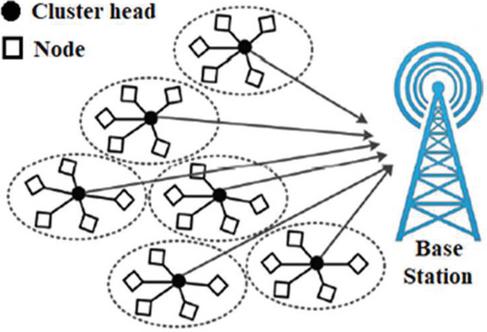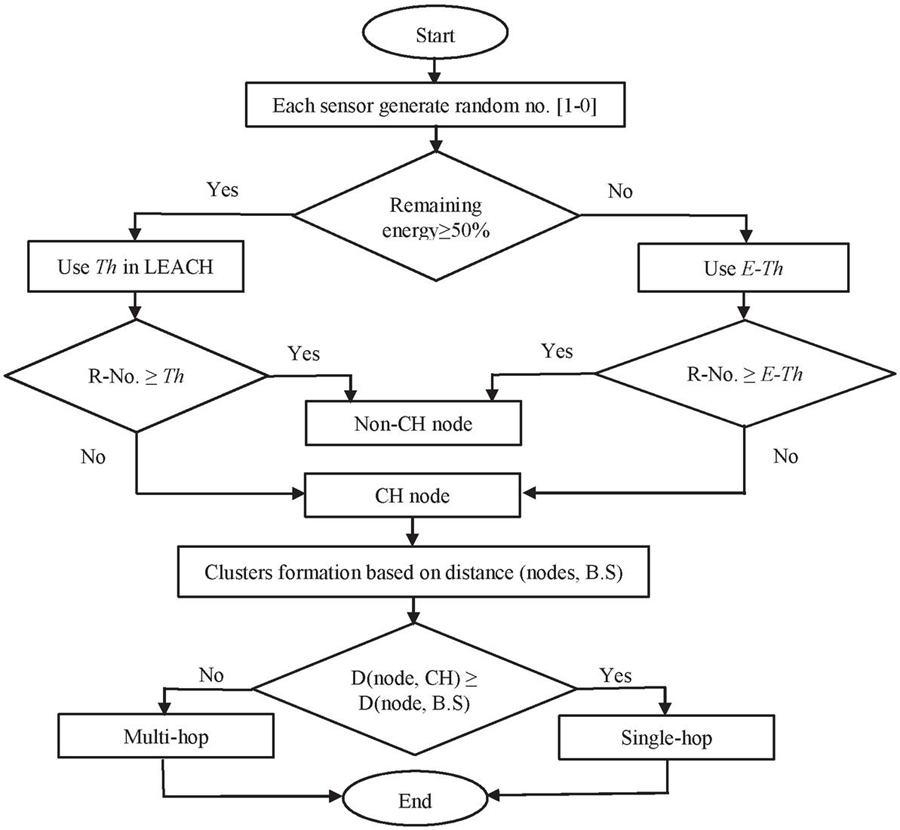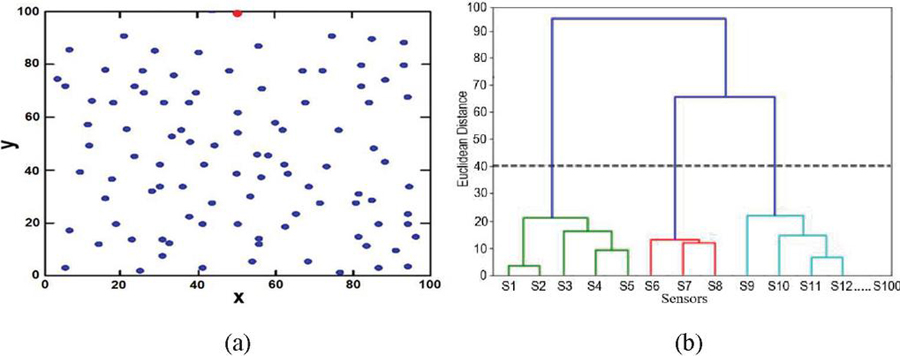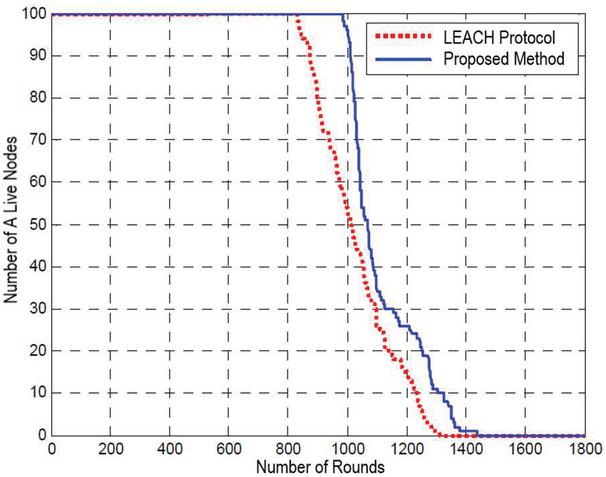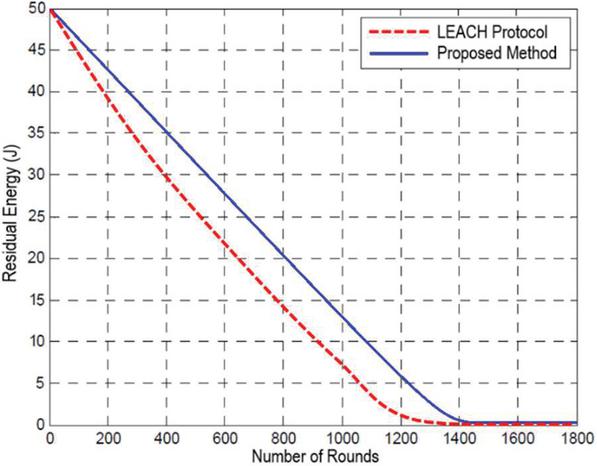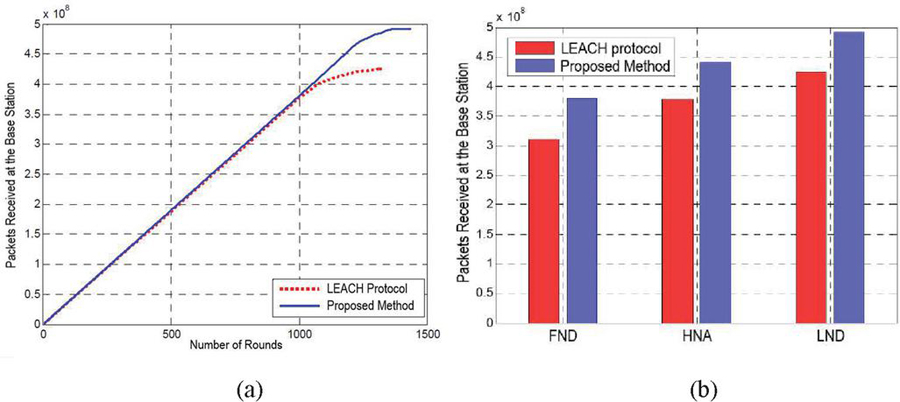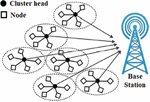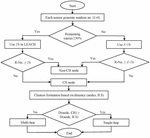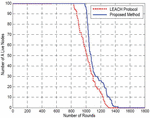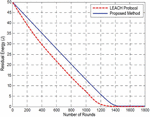Optimization of LEACH Protocol for WSNs in Terms of Energy Efficient and Network Lifetime
Fadhil Mohammed Salman1,*, Ahssan Ahmmed Mohammed1 and Ahmed Fakhir Mutar1, 2
1Ministry of Education, Babylon Education Directorate, Iraq
2Department of Computer Technology Engineering, Al-Mustaqbal University College, Iraq
E-mail: fadhilmohammad2023@bab.epedu.gov.iq; ahssan_ahsan@bab.epedu.gov.iq; ahmedfakhir.mo@bab.epedu.gov.iq
*Corresponding Author
Received 10 October 2022; Accepted 10 December 2022; Publication 16 May 2023
Abstract
Wireless Sensor Network (WSN) is a group of small, intelligent sensors with limited resources. WSN has limited energy restrictions, so, the network lifetime is the major challenge that directly affect the efficiency of the network. This work presents an energy-saving clustering hierarchical algorithm for WSNs; it is an improvement of Low-Energy adaptive Clustering Hierarchy (LEACH) algorithm. The aim of this algorithm is to minimize power consumption by the appropriate election of new cluster heads in every data transfer round and avoid network collisions. This goal achieved by using an efficient function to select the best cluster heads nodes in each round, which takes into account the current energy in the sensors. The proposed algorithm improves the cluster formation process by relying on the shorter distance to the base station. The Time Division Multiple Access (TDMA) mechanism also utilized to schedule the transmission of data packets to cluster heads nodes and to avoid data packet collisions at the base station. Experiments conducted in MATLAB R (2020a) software showed that the suggested algorithm extended the network lifetime by 14.5%, and improved the network throughput by 16.8% compared to the LEACH algorithm. That means, the proposed energy-saving clustering hierarchy algorithm has improved the performance of the LEACH algorithm in term of enhancing network lifetime and increasing network throughput.
Keywords: WSNs, LEACH, clustering, TDMA, MATLAB.
1 Introduction
The great development in microelectronic and electromechanical circuits, in addition to the recent development in wireless communication systems, led to the production of small-sized smart sensors with limited power, which have the ability to communicate wirelessly with each other, forming a network, which called wireless sensor network (WSN). These sensors designed to read the physical changes in the respective environments, convert them into digital signals, and then send them to the base station via other nodes [1]. Since, network sensors have limited battery power and it is very difficult to recharge or change the battery, researchers have developed many solutions to this problem by producing sensors with low-power architectures and developing several energy-saving routing protocols [2].
Low Energy Adaptive Clustering Hierarchy (LEACH) [3] is a common hierarchical clustering protocol proposed to reduce nodes power consumption in WSNs. The LEACH protocol relies on the probabilistic method when choosing which nodes will represent the clusters heads (CHs), since each node will create a random number and then compare it to a certain threshold value, if it is smaller than that, then this node chosen as the CH node. According to this scenario, there are some shortcomings as there is no guarantee in balancing the distribution of power consumption among nodes in clusters, whereas, the remaining energy in the nodes was not taken into consideration when choosing a CH. In addition, the LEACH protocol did not take into account the distance between the sensors and the sink when forming the clusters, which causes poor distribution of nodes to the clusters properly, thus a large waste of energy [3, 4, and 5].
Zhen Zhao, et al., in 2019 [6] proposed a modified protocol depended on the original LEACH algorithm. The proposed protocol addresses the problems of the LEACH protocol, with consideration the factor of remaining power in the nodes as a criterion for selecting cluster heads, and the proposed protocol determines the optimal number of CHs in the network. The results obtained after conducting experiments with the MATLAB simulator showed that the suggested algorithm enhances the stability, lifetime and performance of the network compared to the LEACH algorithm.
Gou, et al., in 2019 [7] defined an energy efficient clustering routing (EECR) method for wireless sensor networks. The suggested method improves upon the LEACH algorithm at the cluster formation stage, as it uses four sub-thresholds, all of which, when designed, depend on the amount of remaining power in the nodes, the number of nodes that represent the CHs, the distance to the base station, and the cycle number in which the node becomes a CH. The proposed protocol also optimized the steady-state phase, utilizing ideal path, multipath attenuation and free spatial models for data transmission to the base station. The results of the experiments displayed that the EECR method effectively extends the lifetime of the WSN compared to LEACH-C, LEACH, EEUC and HEED.
Shilpi Jain, and Navneet Agrawal, in 2020 [8] defined an energy-effective clustering hierarchical algorithm; it is an enhancement of LEACH approach. The proposed approach designed to extend the network lifetime by appropriate election of the cluster heads nodes, depending on the remaining power in the nodes after comparing it to a certain threshold. The proposed algorithm relies on the shortest distance as a determinant to transfer data from CHs nodes to cache node. Simulation result showed that the suggested algorithm performed preferable performance in terms of power consumption, network throughput, alive and dead nodes compared to LEACH approach.
Ikram Daanoune, et al., in 2021 [9] suggested an algorithm to improve the LEACH protocol. The proposed algorithm designed to extend the lifetime of WSNs by appropriate selection of the best nodes to represent as a CHs, taking into consideration the residual power in the nodes, the appropriate number of nodes in each cluster, identifying dead nodes and determining the optimal route for sending packets to the base station. The results of the experiments proved that the suggested approach provided better performance towards extending the network lifetime compared to that achieved by the LEACH protocol.
So, this article focuses on the design and implementation of an energy-saving clustering hierarchy algorithm for the WSNs. The proposed algorithm designed for overcoming the limitations of the LEACH algorithm. The suggested algorithm improves the function of choosing the cluster heads nodes by taking into account the residual power in the sensors, so, the power consumption between the clusters nodes will balanced by precisely selecting the nodes that will represent the CHs nodes. The proposed algorithm also improves the clusters formation process in the LEACH protocol by relying on the shortest distance to the base station as a determinant to connect the node to its appropriate cluster. In addition, the proposed algorithm used a Time Division Multiple Access (TDMA) approach [10] to schedule the transmission of data packets to cluster heads nodes and to avoid data packet collisions at the base station. This article organized as follows: Section 1 introduces WSN with a brief review of the previous literature. Section 2 show an overview of the LEACH protocol. Section 3 provides an overview of the offered system. Section 4 presents details about the suggested algorithm. Section 5 provides analyses of simulation results. Section 6 outlines the conclusions.
2 LEACH Protocol Overview
Low Energy Adaptive Clustering Hierarchy (LEACH) protocol is an important hierarchical clustering algorithm, which designed to minimize power consumption in WSNs. The hierarchical structure of the LEACH protocol built based on distribution of sensors in several clusters, and then every cluster chooses an appropriate node representing as CH, who elected by probability [3]. The processes steps in the LEACH protocol can divided into two main phases: the set-up phase and steady state phase. The first phase includes the process of identifying the CHs nodes in addition to the process of forming the clusters. The second phase of the LEACH algorithm involves initiating nodes to perform their function by sensing data from the respective environments and then sending it to the CHs, which deliver data packets to the sink according to the algorithm’s hierarchical distribution [3, 11]. The process of electing cluster heads based on the principle of probability, where, in every round, each node will generate a random number between zero and one. When, the random number lesser than a certain threshold , this node will chose as the CH node for this round only. However, in the event that the random number is greater than the specified threshold, this sensor will arranged for a specific cluster, based on the approximate distance to the closest CH node. Threshold value can calculated according to the following Equation (1) [3]:
| (1) |
Here, indicates the number of sensor nodes in the network. represents the ratio between the expected numbers of the selected cluster heads to the number of sensors. represents the value of the current cycle. Refers to the set of sensors that was not acted as a cluster head in the final cycles.
The LEACH protocol has many advantages, but it also has some weaknesses, which are as follows [12, 13, and 14]:
1. Do not take into account the amount of energy remaining in the nodes when choosing CHs, so, When a CH node loses power (dies), all cluster sensors become unused, because their packets does not reach the base station in the current cycle.
2. The LEACH algorithm does not care about the distance between the CHs and the sink when transmitting data, which leads to a large waste of energy if the transmission distance is large.
3. The LEACH protocol does not have a specific metric to define the ideal number of CHs in the network, because it adopts the principle of randomness when selecting CHs.
4. After selecting the CHs nodes, the other nodes distributed to the CHs according to the distance between them, so there is a large discrepancy between the numbers of nodes in the different clusters.
5. Some clusters have a CH in the middle, and some at one end of the cluster, which results in a great waste of energy.
6. LEACH algorithm is not effective for very wide WSNs.
3 Overview of the Proposed System
In the LEACH protocol, cluster heads nodes are elected without taking into account the amount of energy remaining in the sensors, sometimes a CH node is selected that does not have enough power to collect and transfer data from the rest of the cluster members to the sink [15]. Therefore, the proposed algorithm used the remaining energy in the nodes as the main parameter when choosing the next CH node, which leads to an increased balance of energy consumption among the network sensors, thus increases the network lifetime. The proposed algorithm also uses the distance parameter (between nodes and the sink) as a determinant of nodes belonging to the appropriate clusters at the stage of cluster formation (in the LEACH protocol, the non-CHs nodes organized with CHs depending on their proximity). The suggested algorithm relies on the multi-hop method to transmit data when the distance between the nodes and the sink is large and the one-hop method when the nodes are close to the sink. These methods reduce the energy consumption of the nodes and gives an opportunity for irregular cluster nodes to connect and transmit data to the sink directly. Figure 1 illustrates the network topology used in this work. It includes a number of sensors randomly installed in a specific area. For obtaining the hierarchical structure, we assumed that the homogeneous network sensors consist of two classes, all of which send data to one fixed base station (sink). The first class of sensors represents the members of clusters. The second category is the nodes representing the CHs, which are the nodes responsible for collecting data packets from other sensors (cluster members) and sending it directly to the sink.
Figure 1 Network topology.
In the proposed algorithm, sensors devices randomly distributed in the specific area, so, in order to have a high chance of relax in working from some limitations, we will define the following assumptions:
1. All devices are fixed in their locations and do not move after installed.
2. The base station is stable in place.
3. All sensors are similar in terms of computational capability and initial power (the network is homogeneous).
4. A GPS antenna does not support sensors.
5. There are no restrictions on the base station in terms of memory, computing capability and power.
6. The sensors do not have any power boost after they are installed, which means that their battery cannot be recharged or replaced once it is in place.
The following algorithm reviews the basic steps of the proposed model:
Step 1. Forming a WSN by deploying (100) sensors with the base station (sink) in a specified area (100 100) meter.
Step 2. The base station broadcasts requests (packets of information) that contain its coordinates in the area.
Step 3. Sensor nodes respond by broadcasting packet of information containing the sensor ID, power level, and coordinates, after receiving a base station request.
Step 4. Neighbours sensor discovery (number of neighbour nodes, remaining energy, distance among sensors and distance to sink).
Step 5. In each cycle, the sink will choose the CHs nodes by comparing the random number generated by each node in the network with a certain threshold (taking into account the amount of energy left in the nodes).
Step 6. CHs nodes broadcast an announcement to the remaining neighbouring nodes for forming the clusters according to the distance between sensors and the sink.
Step 7. CHs (parent nodes) allocate TDMA to each child node, and then sensors start sending their data to their CH (If the distance between the sensor and the CHs is less than the distance between the sensor and the sink, otherwise the node will transmit its data directly to the sink).
More details about the proposed algorithm provided by the following flowchart:
Figure 2 Flowchart of the suggested approach.
4 The Proposed Energy-Saving Clustering Hierarchy Algorithm
4.1 Cluster Heads Determination Phase
Setup phase is the first and most important process in the LEACH protocol, in which CH selected and clusters formed. The process of selecting the cluster heads nodes in the LEACH protocol depends on the principle of probability, and according to this principle, the process of distributing energy consumption among all nodes is not done well (there is no balance in energy consumption between the network nodes). In addition to the fact that the selection of the CHs nodes did not care about the amount of energy remaining in the nodes, in some cases the CH node is chosen and it does not have enough energy and this leads to the death of the nodes at early and varying times [16]. In order to improve the balance of power wastage in the wireless sensor network, the process of determining the suitable CHs nodes will implemented in the proposed algorithm according to the following scenario:
The base station (sink) broadcast the Hello message to all sensor’s devices deployed in the work area. When, the sensors receive hello message, they broadcast an acknowledgement message that includes the node’s ID, the amount of power it has, and the coordinates of its location within the respective region. After the base station receives the acknowledgment message from the sensors, it stores the sensors information in its memory (sensors ID, power level and sensor’s location). Therefore, the base station will learn the complete network topology, based on the information stored in its memory. After that, All network nodes generate a random number with a range from (zero to one), these random numbers will be compared to a certain threshold the CHs nodes. In each round (except for the initial round: the residual power and the initial power are equal), the energy remaining at each node will calculated to determine the appropriate threshold for it. The remaining energy in the contract calculated based on the following relationship [17]:
| (2) |
Here, () represents the remaining energy in the sensor. () stands for the current energy in the sensor. () denotes the energy consumed to send () bits to distance (), and it achieved as follows Equation (3). ) denotes the energy consumed to receive () bits from the transmit node, it achieved as follows Equation (4) [9, 18, and 19]:
| (3) | ||
| (4) |
Here, is the number of bits. The symbol () refers to the path loss exponent, which takes the value (4) when sending the node to the sink, and takes the value (2) when sending the node to the CH. () represents the energy wasted by the electronic circuits of the device. The symbol () denotes the amount of power used by the amplification circuits, it takes the value (0.0013 pJ/bit/m) when sending the sensor to the sink, and takes the value (10 pJ/bit/m) when sending the node to the CH [20, 21].
According to the above, if the amount of remaining energy in a sensor is greater than or equal to 50% of the initial energy of the sensor, then the random number will compared to the threshold used in the LEACH protocol Equation (1). Otherwise, the proposed algorithm will use the following threshold (Equation (5)) to compare with the random number generated in the node.
| (5) |
Where, represents the threshold value. indicates the probability that the device will become CH node. indicates the amount of remaining power in the device. ) indicates the initial energy of the node. According to the previous energy threshold (Equation (5)): when the random number created in a device (between zero to one) is less than the threshold value ), this node will be chosen to be CH.
Figure 3 Clustering by hierarchical technique (a. nodes distribution, b. hierarchical clustering dendrogram).
4.2 Clusters Formation Phase
Agglomerative hierarchical clustering (bottom-up approach) adopted in the proposed algorithm. Where, the clustering approach starts from nodes that are considered as simple clusters, which are collected into new clusters (by distance), until it reaches one cluster. The agglomerative hierarchical clustering method used because the sensors need only one hop to neighbouring nodes to form clusters (therefore, the restrictions of base station are eliminated). In addition, the aggregation algorithm can implemented with or without knowing the location of the nodes (qualitative and quantitative data). After precisely determining which sensors are likely to represent the CHs nodes in this round, the CHs nodes start broadcasting an advertisement message (contains its coordinates) to the surrounding nodes by using CSMA-based MAC protocol [22, 23]. When non-CH nodes receive advertisement messages from CHs, they will decide which CH to join and form the cluster depends on the distance (distance between nodes and CHs, taking into account the distance among CHs and sink). This means that the non-CH nodes will calculate the total distance to the sink through all neighbouring CHs sensors (the distance to neighbouring CH plus the distance from cluster head to the base station), and then choose the CH device that achieves its shortest distance. In the proposed algorithm, the distances calculated according to the Euclidean model [24]. The Euclidean distance adopted because it calculates the distance in a two-dimensional (or multi-dimensional) space. Also, because the sensors features are in the same physical dimensions. Also, because the clustering depends on the shortest straight distance (between each node and adjacent CHs plus the straight distance between the CHs and the base station).
| (6) |
Where, (, ) denotes the x-coordinate of the given nodes. (, ) denotes the y-coordinate of the given nodes.
The agglomerative hierarchical clustering mechanism can depicted using a Dendrogram. Dendrogram is a tree-like diagram that shows the processes of merging or splitting of elements to form clusters, as in the following Figure 3 (the root is the base station (the last singular cluster), the leafs represent the sensors.
After the non-CH nodes selects the appropriate CH that achieves the shortest distance to the base station, this node will send a notification message to the chosen cluster head to telling it that it will join it to form the cluster. This scenario repeated until all network nodes joined to appropriate CH and clusters formed.
4.3 Data Packets Transfer Phase
After the non-CH nodes joined to the appropriate CH node and clusters formed, the data transmission phase begins (steady state period). The CHs sensors will use the Time Division Multiple Access (TDMA) method [6, 25], for allocating a certain time to each member node in their clusters to send data. This means, the member nodes will deliver their packets to their CH device in time slots within a certain period frame. According to the TDMA method, when member nodes have data to transmit at their appointed time, they will switched to wake-up mode. In the event that the member node does not have data to transmit, it will switch to the sleep mode. According to the previous, using TDMA method will reduce nodes energy loss, thus will increase nodes lifetime [26]. In addition, using the TDMA method will reduce packets loss caused by packets collisions, by scheduling the process of sending nodes to the CH, which will save more energy in the nodes [27]. To save more nodes energy, and allow non-uniform nodes to a certain cluster, the proposed algorithm used the following mechanism when sending data:
When a device has data to transmit, it will compare the distance to the sink with the distance to the CH, if it is shorter, it will send its packets directly to the sink, otherwise, it will send its data to its associated CH.
5 Simulation and Discussion of Results
In this part, we used MATLAB R (2020 a) as a simulation software to prove the performance of the suggested algorithm towards reducing node power consumption, extending network lifetime and increasing network throughput. So, the simulation results were compared with the results of the LEACH protocol [3] (according to several performance metrics), to prove the suitability of the suggested protocol for WSNs. The proposed algorithm used Chipcon CC2420 wireless radio parameters, because it consumes little power when sending data [28]. Simulation parameters with their values described in Table 1 [20, 21, and 29].
Table 1 Simulation parameters
| Parameters | Values |
| Number of Homogeneous Sensors | 100 |
| Simulation Area | 100 100 m |
| Packet Size | 4000 bits |
| Hello Packet Size | 25 bytes |
| Initial Energy of each Sensor | 0.5 J |
| Base Station Coordinates | (50,100) |
| Electronics Energy () | 50 nJ/bit |
| Free Space Transmission Amplifier Model () | 10 pJ/bit/m |
| Amplification Energy () | 0.0013 pJ/bit/m |
| Energy for Data Aggregation () | 5 nJ/bit/signal |
Figure 4 Network lifetime.
Three important performance metrics used to validate the results of the suggested algorithm by comparing them with the results of the LEACH protocol, as described in the following subsections:
1. Network lifetime: It refers to the time from the first data packet transmit across the network until the death of the last device in the network. Figure 4 outlines the number of live nodes of the WSN when using the proposed method compared to their number when using the LEACH protocol, per rounds. We clearly note that the number of live nodes during the trial rounds of the suggested method is much larger than that with the LEACH protocol. Where, with the suggested method, the first sensor died after 982 rounds, and all sensors died after 1428 rounds. However, with the LEACH protocol, the first node died after 821 rounds and all sensors died after 1297 rounds. That means, the suggested method has increased the total network time by 14.5% more than using the LEACH protocol. The good performance of the suggested method came because of the high accuracy in selecting new cluster nodes in each data transfer round, depending on the remaining power in the sensors as the key parameter. In addition to the optimal distribution of nodes on groups (based on the distance closest to the sink) and the avoidance of network congestion using TDMA, one-hop and multi-hop techniques, which reduces dropped packets, and thus reduces the power lost to retransmission lost packets. Table 2 describes the death of wireless sensor network devices, when using the proposed protocol and the LEACH protocol, per rounds.
Table 2 Dead nodes, per rounds
| Protocols | First Sensor Die | Middle Sensor Die | Last Sensor Die |
| Proposed | 982 R | 1039 R | 1428 R |
| LEACH | 821 R | 1003 R | 1297 R |
2. Residual energy: This metric indicates the amount of energy wasted to complete the node tasks (aggregating, sending and receiving data). Figure 5 shows how much power consumed in the network during the simulation period when using the proposed algorithm and the LEACH protocol. Figure 5 clearly shows that the proposed algorithm consumed less power up to 95% of simulation time, compared to its amount when using the LEACH protocol. This means, the proposed algorithm has increased network lifetime and throughput much more than when using the LEACH algorithm. The good performance of the suggested algorithm due to the appropriate selection of the CHs nodes (based on the amount of power left in the nodes), which led to an increase in the balance of power exhaustion among sensors and an increase in the network stability period.
Figure 5 Residual energy (J).
Figure 6 No. packets received at the sink.
3. Network throughput: This metric indicates the total number of packets transmitted over the network, which successfully reached the final destination (sink), per second. Figure 6(a) clearly showed that the total number of packets that successfully reached the sink when using the suggested method is much greater than when using the LEACH protocol. That means the suggested method achieved the highest throughput compared to the LEACH algorithm, because the network throughput is largely dependent on the total number of data packets successfully accessed at the sink. Where, the LEACH protocol achieved 4280 10 data packets, while the suggested method achieved 4991 10 data packets received at the sink. This means, the suggested method has increased network throughput by 16.8% compared to its throughput when using the LEACH algorithm. Figure 6(b) displays that the suggested method achieved higher throughput than that achieved with LEACH during the simulation period, relative to first node death (FND), half nodes alive (HNA), and last node death (LND). The high network throughput achieved by the suggested method came because of having more live nodes during the simulation period (more live nodes means sending more packets to the CHs and sink [30]). In addition, the high throughput of the suggested method is definitely the result of using a mechanism to send data packets through the shortest path, which reduces dropped packets. As well as, using the TDMA method that defines the scheduling process to send nodes to the base station and thus reduce data packet collision, which leads to a reduction in the number of lost packets. Table 3 shows the total WSN throughput, when using the proposed protocol and the LEACH protocol, per rounds.
Table 3 Network throughput, per rounds
| Protocols | Number of Data Packets Received at the Sink |
| Proposed | 4991 10 |
| LEACH | 4280 10 |
6 Conclusions and Future Works
In this work, we introduced an energy-saving cluster hierarchy algorithm for WSN networks, which designed as an optimization of the LEACH protocol, with the aim of reducing sensors power consumption and extending network lifetime. The MATLAB simulator used to perform simulation experiments and analyse the results of the suggested algorithm by comparing it with the performance of the LEACH protocol using three metrics (network lifetime, residual power and network throughput). The results of the experiments clearly displayed that the proposed algorithm extended the network lifetime by 14.5% more than when using the LEACH protocol. Experiments showed that the proposed algorithm consumes less energy up to 95% of the experiments time compared to the energy consumed with the LEACH protocol. Our results also showed that the suggested algorithm increased the network throughput by about 16.8% compared to its throughput when using the LEACH protocol. According to the results of the experiments, the proposed algorithm is more energy effective and more throughput than the LEACH algorithm. This is because the proposed algorithm uses the remaining energy in the nodes as a key parameter in the process of selecting cluster heads, addition to using the distance to the base station as the main determinant of the distribution of sensors over the clusters. However, there are still some shortcomings in the proposed algorithm: first, it does not specify the ideal number of sensors that will act as CHs (because the algorithm adopts the principle of randomness in the process of selecting CHs). Second, the suggested algorithm is not ideal for wide area networks (because the data goes directly from the CHs to the sink). In the future, the proposed algorithm can be developed through the use of precise search methods (such as fuzzy logic or genetic algorithm) to select suitable CH nodes, form clusters, and determine the least expensive transmission paths. In the future, we plan to enhance the suggested algorithm by applying the principle of multiple levels to its structure, to make it suitable for very wide networks. The proposed algorithm extends by implementing a mechanism to determine the ideal number of CHs, and to identify the secondary CHs in order to minimize the energy consumption of the main CHs. In the future, it is possible to add new security features to increase the reliability of the suggested algorithm in order to keep the transmitted data confidential.
References
[1] G. Tamilselvan and K. Gandhimathi, “Network coding based energy efficent LEACH protocol for WSN,” Journal of applied research and technology, vol. 17, no. 1, pp. 1–7, 2019.
[2] S. D. Indu, “Wireless sensor networks: Issues & challenges,” International Journal of Computer Science and Mobile Computing (IJCSMC), vol. 3, pp. 681–85, 2014.
[3] W. R. Heinzelman, A. Chandrakasan, and H. Balakrishnan, “Energy-efficient communication protocol for wireless microsensor networks,” in Proceedings of the 33rd annual Hawaii international conference on system sciences, 2000: IEEE, p. 10 pp. vol. 2.
[4] J. Zhao and L. Yang, “LEACH-A: An adaptive method for improving leach protocol,” Sensors & Transducers, vol. 162, no. 1, p. 136, 2014.
[5] N. Qubbaj, A. A. Taleb, and W. Salameh, “Review on LEACH Protocol,” in 2020 11th International Conference on Information and Communication Systems (ICICS), 2020: IEEE, pp. 414–419.
[6] Z. Zhao, G. Li, and M. Xu, “An improved algorithm based on LEACH routing protocol,” in 2019 IEEE 19th International Conference on Communication Technology (ICCT), 2019: IEEE, pp. 1248–1251.
[7] P. Gou, F. Li, Z. Li, and X. Jia, “Improved LEACH protocol based on efficient clustering in wireless sensor networks,” Journal of Computational Methods in Sciences and Engineering, vol. 19, no. 3, pp. 827–838, 2019.
[8] S. Jain and N. Agrawal, “Development of energy efficient modified LEACH protocol for IoT applications,” in 2020 12th International Conference on Computational Intelligence and Communication Networks (CICN), 2020: IEEE, pp. 160–164.
[9] I. Daanoune, A. Baghdad, and A. Ballouk, “Improved LEACH protocol for increasing the lifetime of WSNs,” Int. J. Electr. Comput. Eng. IJECE, vol. 11, pp. 3106–3113, 2021.
[10] K. H. Mohammadani, K. A. Memon, I. Memon, N. N. Hussaini, and H. Fazal, “Preamble time-division multiple access fixed slot assignment protocol for secure mobile ad hoc networks,” International Journal of Distributed Sensor Networks, vol. 16, no. 5, p. 1550147720921624, 2020.
[11] F. Dressler, R. Koch, and M. Gerla, “Path heuristics using ACO for inter-domain routing in mobile ad hoc and sensor networks,” in International Conference on Bio-Inspired Models of Network, Information, and Computing Systems, 2010: Springer, pp. 128–142.
[12] K. H. Mohammadani, K. A. Memon, I. Memon, N. N. Hussaini, and H. Fazal, “Preamble time-division multiple access fixed slot assignment protocol for secure mobile ad hoc networks,” International Journal of Distributed Sensor Networks, vol. 16, no. 5, p. 1550147720921624, 2020.
[13] F. Dressler, R. Koch, and M. Gerla, “Path heuristics using ACO for inter-domain routing in mobile ad hoc and sensor networks,” in International Conference on Bio-Inspired Models of Network, Information, and Computing Systems, 2010: Springer, pp. 128–142.
[14] S. Bharany et al., “Energy-efficient clustering scheme for flying ad-hoc networks using an optimized LEACH protocol,” Energies, vol. 14, no. 19, p. 6016, 2021.
[15] T. Salam and M. Hossen, “Performance analysis on homogeneous LEACH and EAMMH protocols in wireless sensor network,” Wireless Personal Communications, vol. 113, no. 1, pp. 189–222, 2020.
[16] T. M. Behera et al., “Energy-Efficient Routing Protocols for Wireless Sensor Networks: Architectures, Strategies, and Performance,” Electronics, vol. 11, no. 15, p. 2282, 2022.
[17] T. Mahmood et al., “An intelligent fault detection approach based on reinforcement learning system in wireless sensor network,” The Journal of Supercomputing, vol. 78, no. 3, pp. 3646–3675, 2022.
[18] K. H. Mohammadani, K. A. Memon, I. Memon, N. N. Hussaini, and H. Fazal, “Preamble time-division multiple access fixed slot assignment protocol for secure mobile ad hoc networks,” International Journal of Distributed Sensor Networks, vol. 16, no. 5, p. 1550147720921624, 2020.
[19] F. Dressler, R. Koch, and M. Gerla, “Path heuristics using ACO for inter-domain routing in mobile ad hoc and sensor networks,” in International Conference on Bio-Inspired Models of Network, Information, and Computing Systems, 2010: Springer, pp. 128–142.
[20] S. Bharany et al., “Energy-efficient clustering scheme for flying ad-hoc networks using an optimized LEACH protocol,” Energies, vol. 14, no. 19, p. 6016, 2021.
[21] T. Salam and M. Hossen, “Performance analysis on homogeneous LEACH and EAMMH protocols in wireless sensor network,” Wireless Personal Communications, vol. 113, no. 1, pp. 189–222, 2020.
[22] T. M. Behera et al., “Energy-Efficient Routing Protocols for Wireless Sensor Networks: Architectures, Strategies, and Performance,” Electronics, vol. 11, no. 15, p. 2282, 2022.
[23] T. Mahmood et al., “An intelligent fault detection approach based on reinforcement learning system in wireless sensor network,” The Journal of Supercomputing, vol. 78, no. 3, pp. 3646–3675, 2022.
[24] S. K. Singh, P. Kumar, and J. P. Singh, “A survey on successors of LEACH protocol,” IEEE Access, vol. 5, pp. 4298–4328, 2017.
[25] S. Dutt, G. Kaur, and S. Agrawal, “Energy efficient sector-based clustering protocol for heterogeneous WSN,” in Proceedings of 2nd International Conference on Communication, Computing and Networking, 2019: Springer, pp. 117–125.
[26] Q. Wang, D. Lin, P. Yang, and Z. Zhang, “A fuzzy-logic based energy-efficient clustering algorithm for the wireless sensor networks,” in 2018 26th International Conference on Software, Telecommunications and Computer Networks (SoftCOM), 2018: IEEE, pp. 1–6.
[27] K. Jain and A. Singh, “A two-vector data-prediction model for energy-efficient data-aggregation in wireless sensor network,” Concurrency and Computation: Practice and Experience, vol. 34, no. 11, p. e6898, 2022.
[28] N. R. Roy and P. Chandra, “A note on optimum cluster estimation in leach protocol,” IEEE Access, vol. 6, pp. 65690–65696, 2018.
[29] K. A. Darabkh, M. Z. El-Yabroudi, and A. H. El-Mousa, “BPA-CRP: A balanced power-aware clustering and routing protocol for wireless sensor networks,” Ad Hoc Networks, vol. 82, pp. 155–171, 2019.
[30] H. B. Eldeeb, E. Yanmaz, and M. Uysal, “MAC layer performance of multi-hop vehicular VLC networks with CSMA/CA,” in 2020 12th International symposium on communication systems, networks and digital signal processing (CSNDSP), 2020: IEEE, pp. 1–6.
[31] R. B. Pedditi and K. Debasis, “A Low Energy Consuming MAC Protocol for Wireless Sensor Networks,” in 2022 2nd International Conference on Artificial Intelligence and Signal Processing (AISP), 2022: IEEE, pp. 1–5.
[32] C. Donnat and S. Holmes, “Tracking network dynamics: A survey using graph distances,” The Annals of Applied Statistics, vol. 12, no. 2, pp. 971–1012, 2018.
[33] S. Faruque, Radio frequency multiple access techniques made easy. Springer, 2019.
[34] C. Trinh, B. Huynh, M. Bidaki, A. M. Rahmani, M. Hosseinzadeh, and M. Masdari, “Optimized fuzzy clustering using moth-flame optimization algorithm in wireless sensor networks,” Artificial Intelligence Review, vol. 55, no. 3, pp. 1915–1945, 2022.
[35] S. Faruque, Radio frequency multiple access techniques made easy. Springer, 2019.
[36] C. Trinh, B. Huynh, M. Bidaki, A. M. Rahmani, M. Hosseinzadeh, and M. Masdari, “Optimized fuzzy clustering using moth-flame optimization algorithm in wireless sensor networks,” Artificial Intelligence Review, vol. 55, no. 3, pp. 1915–1945, 2022.
[37] M. B. Latif, F. Liu, and K. Liu, “A TDMA-Based MAC Protocol for Mitigating Mobility-Caused Packet Collisions in Vehicular Ad Hoc Networks,” Sensors, vol. 22, no. 2, p. 643, 2022.
[38] A. W. Bhat and A. Passi, “Wireless Sensor Network Motes: A Comparative Study,” in 2022 9th International Conference on Computing for Sustainable Global Development (INDIACom), 2022: IEEE, pp. 141–144.
[39] A. Panchal, L. Singh, and R. K. Singh, “RCH-LEACH: Residual energy based cluster head selection in LEACH for wireless sensor networks,” in 2020 International Conference on Electrical and Electronics Engineering (ICE3), 2020: IEEE, pp. 322–325.
[40] R. Alsaqour, E. S. Ali, R. A. Mokhtar, R. A. Saeed, H. Alhumyani, and M. Abdelhaq, “Efficient Energy Mechanism in Heterogeneous WSNs for Underground Mining Monitoring Applications,” IEEE Access, vol. 10, pp. 72907–72924, 2022.
Biographies

Fadhil Mohammed Salman received his BS in computer science from Unvirsty of Anbar in Iraq 2005. From 2010 to 2012, he completed his master’s study in Computer Science from the Department of Computer Science University of Babylon, Iraq. He received the PhD thesis in information technology from the Department of Software College of Information Technology University of Babylon, Iraq, in 2019. He is lecturer in the Babylon Education Directorate since 2007 till now. His research interests include the computer network, Network security, Data compression, Image processing, and Data mining.

Ahssan Ahmmed Mohammed received his BS in computer science from Unvirsty of Babylon in Iraq 2006. From 2009 to 2011, he completed his master’s study in Computer Science from the Department of Computer Science and Information Technology at Dr. BabaSahib Ambedkar Marthwada University, India. He received the PhD thesis in information technology from the Department of Software College of Information Technology University of Babylon, Iraq, in Abril 2018. He is lecturer in the Babylon Education Directorate since 2008 till now. His research interests include the information security, Network security, Cryptography, Steganography, Image processing, and Data mining.

Ahmed Fakhir Mutar received his BS and MSc in computer science from University of Babylon in Iraq in 2008 and MSc in computer science in Mustansiriyah University in Iraq in 2018, respectively. From 2018 to 2022, he worked as a lecturer in Department of Computer Technology Engineering in the AL- Mustaqbal College of Babylon. In February 2019, he started working as a lecturer in the Babylon Education Directorate Since 2009, in addition to participating in the administrative and scientific committees. His research interest includes Information security and image processing, Computer Network.
Journal of Cyber Security and Mobility, Vol. 12_3, 275–296.
doi: 10.13052/jcsm2245-1439.1232
© 2023 River Publishers
